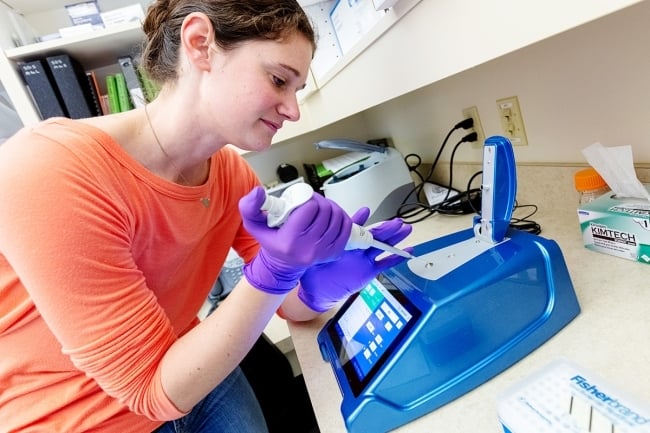You have /5 articles left.
Sign up for a free account or log in.

Between 1996 and 2020, academic technology transfers in the United States contributed $1.9 trillion in gross industrial output.
National Park Service/rawpixel
A bipartisan group of federal lawmakers has joined research universities in opposition to a proposed Biden administration framework that would allow the government to seize patents from federally funded inventions if it deems products developed from them too expensive.
Proponents of the potential new guidelines have framed it as an avenue for lowering prescription drug prices. But critics say it wouldn’t be effective at doing that and it would undermine research partnerships between universities and private companies.
“The draft framework would upend these public-private partnerships and chill private-sector investment in university intellectual property,” says the opposition letter signed by 28 members of Congress and sent to President Joe Biden on Feb. 21. “The result: many valuable technologies would not move beyond the campus lab.”
The proposal put forth in December by the National Institute of Standards and Technology (NIST), an agency in the Department of Commerce, seeks to change the framework of the Bayh-Dole Act of 1980, which “has allowed American universities—like the University of Delaware, North Carolina State University, Massachusetts Institute of Technology, Penn State University, and Arizona State University—and small businesses to commercialize products and be competitive in an increasingly global market,” according to the opposition letter.
“Unfortunately, the draft guidance framework that the [NIST] recently issued on the use of march-in rights under the Bayh-Dole Act threatens this system without achieving its stated objective of reducing prescription drug prices.”
The “march-in” provision of the law allows the government to take control of a federally funded invention to alleviate health or safety concerns. However, no presidential administration to date has approved an agency’s march-in petition on the basis of price control. If the NIST approved the language of the proposed framework, that would explicitly make “the reasonableness of the price” grounds for a march-in.
Before Bayh-Dole became law more than 40 years ago, universities had little incentive to find practical uses for their inventions, because the government owned the intellectual property of any discoveries made with federal research dollars. As a result, fewer than 5 percent of the 28,000 patents then held by federal agencies had been licensed for use, according to the U.S. Government Accountability Office.
But Bayh-Dole changed that by allowing universities to transfer inventions to industry partners for commercialization, which has resulted in bringing to market groundbreaking technologies in the pharmaceutical industry and beyond.
Between 1996 and 2020, academic technology transfers in the United States contributed $1.9 trillion in gross industrial output, supported 6.5 million jobs and resulted in more than 126,000 patents awarded to research institutions, according to data from the Association of University Technology Managers, or AUTM.
AUTM has also joined the Association of American Universities, the Association of American Medical Colleges, the American Council on Education, the Association of Public and Land-grant Universities, and the Council on Governmental Relations in opposing changes to the Bayh-Dole framework.
Lower Drug Prices?
For decades, health-care advocates have argued that the government should use the march-in provision to control prescription drug prices. But the authors of the law have previously said that language was purposefully left out of the legislation and that Congress would have to amend it.
Although Congress has never acted, the NIST’s proposal to make price a factor for a march-in would bypass the need for congressional approval.
While a bipartisan contingent in Congress opposes the change, another group of lawmakers supports it.
“Reining in out-of-control prescription drug prices is one of the most pressing challenges facing the United States,” reads a letter of support signed by more than 70 other members of congress, including Senators Elizabeth Warren and Bernie Sanders, sent to the Departments of Commerce and Health and Human Services on Feb. 6. “As the angel investors underwriting the risk of development, taxpayers deserve access to these products on reasonable terms, including fair pricing that accounts for the investment made.”
Although most opponents of the measure agree that some prescription drugs are priced too high, they don’t believe that altering Bayh-Dole is the answer.
That’s because even though a university may have used federal dollars to fund the discovery of one component of a marketable product, such as a groundbreaking new drug, other patentable components may not have been produced using federal funds and therefore couldn’t be subjected to a march-in.
Between 2011 and 2020, the Food and Drug Administration approved 361 pharmaceutical products, but fewer than 2 percent of those could even be subject to full march-in rights, according to data from Vital Transformations, a health-care consulting firm.
“That leaves only the serious unintended consequences of NIST’s draft framework, which would apply to all types of technologies and products, not just pharmaceuticals,” the congressional opposition letter said.
Universities Already Feeling the Chill
Changing Bayh-Dole would open the door for rival companies, and “even our foreign competitors and adversaries,” to use a price-based march-in as “a tool to cast a cloud over the companies—many of them small business and start-ups—that drive our economy,” congressional opponents said in the letter. “The increased risk of losing control over critical patents also threatens to deter the private investment necessary to commercialize products incorporating federally funded research, preventing the public from benefiting from that research.”
Joseph Allen, executive director of the Bayh-Dole Coalition and a former Senate staffer who helped get the 1980 legislation passed, said he’s already seeing that hesitation in anticipation of changes to the framework.
“A number of universities are already saying this is having an impact on people’s willingness to license new technologies,” he said, noting that around 70 percent of university licenses go to small companies. “If those companies are afraid that they could license the technology—they put their own money into developing it and bringing it to market—and someone can say, ‘I don’t like your price’ and take it away from them, they’re just not going to do that. No one is going to take that risk.”
Allen said he’s encouraged by the recent congressional opposition to changing the Bayh-Dole framework.
“This guideline is an attempt to change the law without amending it through Congress,” he said. “That’s not a power of the executive branch.”
Kate Hudson, a lobbyist for the AAU, said she’s also heartened by the congressional opposition.
“The letter is to reframe the discourse and to show that Congress is not aligned on this,” she said, “and to exert some political pressure on the administration to second-guess what they’re trying to do.”
But it will be up to NIST to finalize the guidelines, which could happen at any time.
“I would imagine if they are going to go through with this it will be sometime in late April or May so that it could be used on the campaign trail,” Hudson said. “This would be touted as a major accomplishment for lowering drug prices.”



